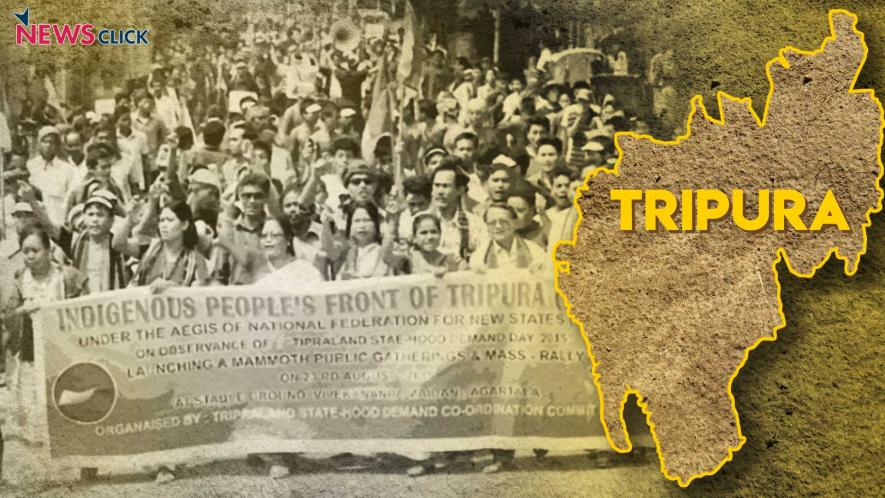Who Will Blink First?

Newsclick Image By Nitesh
On March 25, the Indigenous People’s Front of Tripura (IPFT) reiterated its commitment to the statehood demand. On March 18, Mewar Kumar Jamatia the Minister for Forests and Tribal Welfare in the Government of Tripura attended a meeting of the National Federation for New States (NFNS) in Delhi. This occurred despite the BJP led Government in Tripura allying with the IPFT on the basis that the statehood demand is dropped. The BJP has been unusually tight-lipped about these developments. On March 24, the Union Minister of State for Home Affairs told the Rajya Sabha that there was no high-level monitoring committee formed to look into the demand for a separate state. However, N. C. Debbarma, the leader of the IPFT, had in the past claimed that the Union Government was positive about Twipraland.
The demand for ‘Twipraland’ is for a separate state consisting of all the Tribal Autonomous District Council (TADC) areas in Tripura. The TADC areas constitute roughly two-thirds of Tripura’s total area and mostly consist of hills. However, ‘tribals’ constitute around one-third of Tripura’s population. The history of the ‘tribal’ people of Tripura is not a happy story. They had been systematically marginalized by the Kings of the Manikya dynasty. The Kings were the first to settle people from Bengal in the plains surrounding Agartala. This later reached a crescendo with the language of the Royal Court being changed from Kok-Borok to Bengali. This was also when Tripura officially became the Hindu Kingdom. The traditional forms of worship were sidelined as well.
Cutting forward in time to the period of the Indian Independence movement, the settlers from Bengal had been given the title to their lands. The tribal revolts against taxation by the King had been brutally suppressed. In this scenario, Leftist organisations began organising literacy programmes for the tribal people in Tripura. They promoted the use of Kok-Borok and organised the tribals into a political force. This too was suppressed by the King who was a British ally and did not wish for Tripura to become a hotbed of anti-colonial struggle. The settlers too did not participate in the Independence movement, probably because they did not wish to anger the King who had given them land.
At the time of Tripura’s merger, the Kingdom was handed over in totality, there was never any question of separatism then. However, by then the literacy programmes conducted by the Left as well as Kok-Borok becoming the lingua franca of the tribals had sowed the seeds for Tripuri ethnonationalism. The first demand that came out of this new found national consciousness was for autonomy. This led to the creation of the TADCs. However, constituting a minority population with low income and literacy levels, the TADCs did little to improve the position of the tribal population. For one, in electoral politics, numbers matter. An unspoken truth in Indian politics is that people vote for the community if not for the individual. Hence, despite having reserved seats, Tripura is yet to see a ‘tribal’ Chief Minister.
If anything, the symbolism of having a government led by one’s own tends to add to a community’s sense of upliftment. Of course, identities are not fixed and singular, however, in most parts of the Northeast, identity is based either on language or on the tribal identity. Religion does not play as big a role in most states other than possibly Assam. Thus, the feeling of belonging to the first existing community and yet impotent due to modern electoral politics has led to frustration in the tribals. The earliest demands for Twipraland were confused pronouncements. For one, the people were unable to decide whether Twipraland would be a sovereign State or a separate state within India. Groups like the Tripura National Volunteers (TNV) had given up arms after the TADCs were created. However, the National Liberation Front of Tripura (NLFT) All Tripura Tribal Force (ATTF), which later substituted ‘Tribal’ for ‘Tiger’ in their name took up arms for sovereignty.
The two groups launched ethnic cleansing pogroms against the Bengali population of Tripura. This led to the rise of Amra Bangla who did the same, but with tribals in their crosshairs. Thus, a positive feedback loop was created, with one act of violence feeding into another. However, the Left government should be applauded for being able to contain the violence and ensure that the riots of the 1980s were not repeated. However, the violence exposed the fragility of peace in an ethnically conscious region. Following the ethnic violence in Tripura, the IPFT was formed to push forward a demand for a separate state within the Indian Union.
The IPFT won 8 out of 9 contested seats in the 2018 Assembly elections. This is a turning point for the IPFT, which had otherwise been a fringe player. The main platform of the party was the creation of Twipraland. However, the BJP has never endorsed the demand. They remained opaque on Gorkhaland despite S. S. Ahluwalia being elected from Darjeeling due to support extended by the Gorkha Janmukti Morcha. They have strained relations with Bodo political parties over their stand on Bodoland. Now, it appears that their relationship with the IPFT will become untenable in the near future. The problem is that one misstep for either the IPFT or the BJP can lead to either the IPFT becoming a non-entity or a renewed violent agitation for statehood.
Get the latest reports & analysis with people's perspective on Protests, movements & deep analytical videos, discussions of the current affairs in your Telegram app. Subscribe to NewsClick's Telegram channel & get Real-Time updates on stories, as they get published on our website.
























